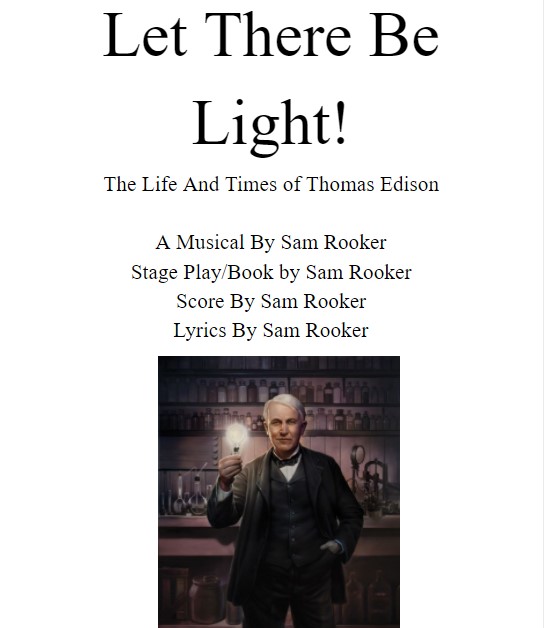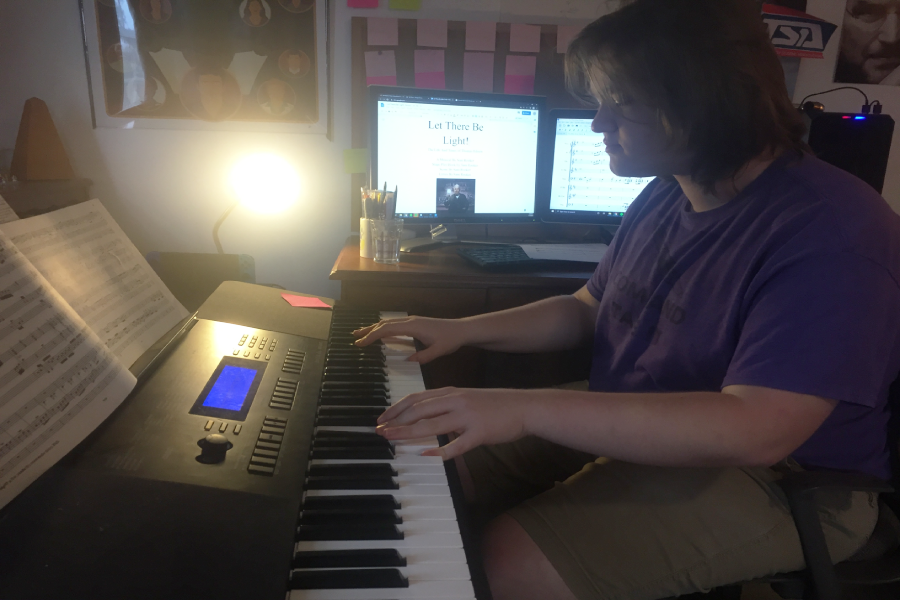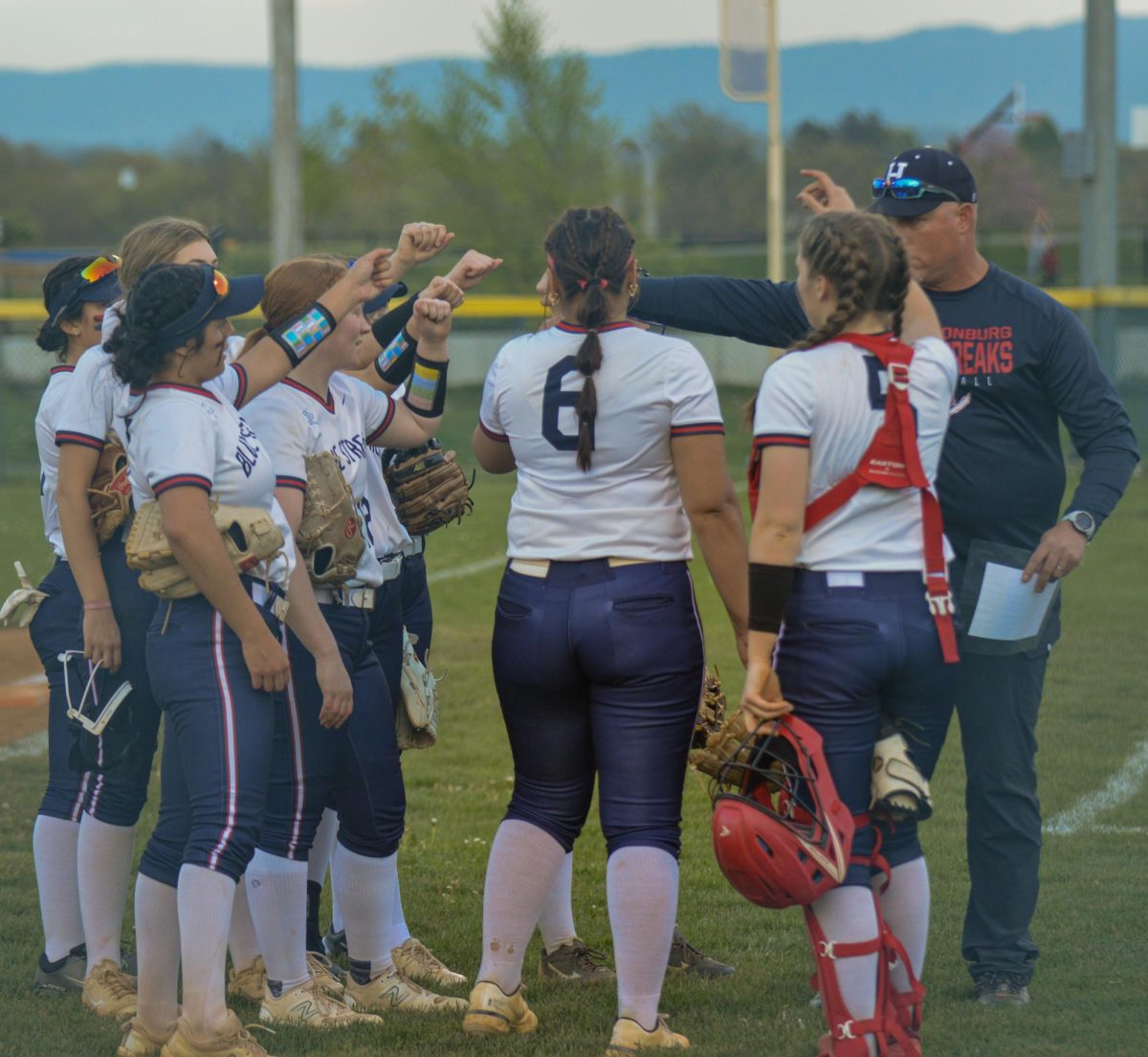Rooker writes original musical about Thomas Edison
Photo Republished with Permission From Sam Rooker
Junior Samuel Rooker works on music for his original musical “Let there Be Light! The Life and Times of Thomas Edison.”
March 31, 2021
After watching Gilbert and Sulivan’s “The Pirates of Penzance” at the Forbes center in Harrisonburg, junior Samuel Rooker became a fan of musicals. This led him to participate in productions throughout middle school. His first performance was the musical “Mulan” in fifth grade, followed by his roles in “The Wizard of Oz,” “Les Miserables,” “Shrek the Musical” and “The Phantom of Opera.” Alongside performing, Rooker has also written several short film scripts; however, none have been as big of a production as his original musical “Let there Be Light! The Life and Times of Thomas Edison.”
“I had always wanted to try my hand at writing a musical. I started [to] work on a musical back in 2018 called ‘Romero and Julius,’ which was a modern adaptation of Shakesphere’s ‘Romeo and Juliet’ set in the 1970s at the Woodstock Music Festival. Before that, I had the idea for a stage play that was an adaptation of Mary Shelley’s ‘Frankenstein,’” Rooker said. “It was going to be about two brothers who build an artificially intelligent android, and a religious extremist who wants to destroy their creation. Both of these projects fizzled out after about two or three drafts of their first acts.”
Leaving behind the unfinished projects, Rooker picked up the book “The Wizard of Menlo Park” by American author Randall E. Stross. The book tells the story of Thomas Edison and his greatest achievements.
“I found the book intriguing and I started to realize the profound impact that Edison and his staff at Menlo Park had on the world. I also found Edison’s story enduring. The way he overcame struggles in his childhood, and the death of his first wife made him a formidable captain of industry. I also appreciated the fact that Edison built himself up from nothing. He didn’t have the great family name that Vanderbilt and Rockefeller possessed; yet, in the span of 25 years he built himself up as a great innovator and businessman,” Rooker said.
Most famously known for inventing the light bulb, phonograph and the movie camera viewer, the accomplishments of Thomas Edison never fail to escape history classrooms. Although, alongside the fame Edison gained came misconceptions about his inventions, to which Rooker hopes to shed the truth on.
“In recent years, there have been a lot of misconceptions about Edison and what he did and did not invent or patent. The truth is this: Edison was still a great inventor. Too many historians are quick to write off Edison’s accomplishments as just the work of his staff at Menlo park rather than Edison’s own work,” Rooker said. “Edison had a great many inventions that he himself designed and built such as the quadruplex telegraph, the Edison cylinder phonograph, of course the carbon coated bamboo lightbulb filament and many more. My goal with this musical is to reform these misconceptions and show Edison as a complicated character rather than a complete villain.”
The task of creating a musical is no small one and it takes a good amount of time. For Rooker, it has been a three year process that is still ongoing. Rooker started out by writing the story as a play, but once he realized the scale and tone he wanted the story to have, changed the format to fit a musical style. A lot goes into writing a musical for Rooker, from the heavy research needed to all the original music that has to be created.

“I started by collecting all of the information I could on the period and Edison’s life. I then created a timeline that even now hangs above my desk and my piano keyboard. The timeline has 112 events listed on it, from the day Edison was born to the day he died. I then started the writing process. The process was long and often tedious, but I found myself going to sleep frustrated and waking up energized. I finished the first draft of the first act this past summer, and it includes over 60 pages of dialogue. By the time I have finished the score and all the songs, it will be well over 100 pages,” Rooker said. “The next step is to start scoring the musical, which includes writing out the voice lines, the piano leading sheet and the full score. After that, I will begin work on Act 2 and, while I have planned it, it is nowhere near complete. But [for now], I have put the process on hold to focus on my classes for the rest of the year.”
Rooker decided the best way to format the story would be through a narrative perspective offered from two teachers. He wanted to give the story context and felt that using a teacher’s perspective would allow for a stronger tone to be set on the story.
“The musical is titled: ‘Let there Be Light! The Life and Times of Thomas Edison.’ The story follows Edison from when he is a young man through his removal from the Edison Electric Company by the executive board. The whole story is narrated by a science teacher and a history teacher who have tableaus where they are teaching their students about Thomas Edison. The first act ends with Edison unveiling his lightbulb to the world in a soliloquy titled ‘Let the Light Shine On.’ The second act is mostly about the feud between Westinghouse and Edison, and it opens with a song titled ‘Let there be War,’ which is a play on words with the current war which was the battle between AC and DC,” Rooker said.
The most important part of the story is the theme and Rooker is set on telling the story of the great inventor Thomas Edison.
“The theme of the musical is, ‘It’s about the man, not the machine.’ I think a good example of the message I am trying to convey is evident in a scene I wrote recently. This scene takes place at the end of the show and is the final scene as all of the inventors and historical figures have a final ballad together,” Rooker said.










